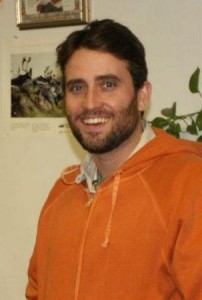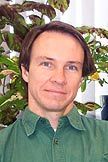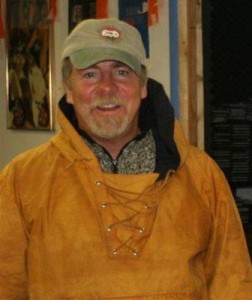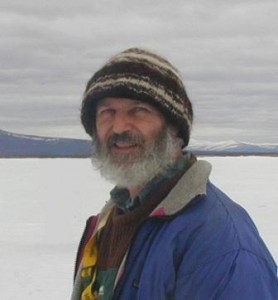Instead of focusing on a single researcher, this month’s article presents some of the challenges of sharing what is known about climate change from the perspectives of Native Alaskans and “Western scientists.” This approach is similar to a research strategy called triangulation, in which a combination of approaches, data sets, and investigations is used to answer a question, thus increasing confidence in the resulting analyses.
Triangulation may be particularly useful for understanding climate change, which is rapidly affecting the polar regions. It is vital to apply all available knowledge, including the knowledge and wisdom of Native Arctic peoples, in scientific research efforts to inform policymakers about the potential impacts of climate change. However, these efforts are often complicated by differences between the Western definition of “science” and the more holistic ways of knowing found in Native cultures.
EXPERIMENTAL VERSUS EXPERIENTIAL LEARNING
Since the time of the early Greeks, science has defined and shaped what is understood by Western societies about Earth and its processes. Often referred to as “Western science” by sociologists, philosophers, and historians, modern-day science can be defined as the systematic study of the structure and behavior of the physical and natural world through observation and experiment. It prizes standardized methods of data collection, analyses, and communication; as well as experimentation with variables. Where physical manipulation of variables is too dangerous or too expensive or, in the case of complex systems such as weather and ecosystems, not feasible, models based on mathematical expressions can be used to simulate changes and predict outcomes.
In contrast, Native peoples who live a traditional lifestyle come to understand their natural environment by experiential learning. Their daily observations and interactions with nature offer a deep and rich awareness that is holistic and embedded in their cultural understandings, which are shared verbally and passed from generation to generation, often in the form of stories. The knowledge and wisdom of Native peoples have been given many labels, including Native Ways of Knowing (NWK) and Traditional Environmental Knowledge or Traditional Ecological Knowledge (TEK).
Native peoples have a long history of observing changes in their environment and testing their ideas over time. Indeed their survival may have depended on having been attentive to (and adapting to) those changes. Furthermore, while belief systems about the significance of human existence and behavior fall outside the realm of Western science, Native peoples traditionally recognize the spirits of all other species and objects and acknowledge that humans are simply a part of the natural world. Unlike Western science, Native Ways of Knowing includes meaningful stories that are shared orally from generation to generation to help each person understand and maintain the necessary balance between the human, natural, and spiritual realms.
A NATIVE ALASKAN’S EXPERIENCE
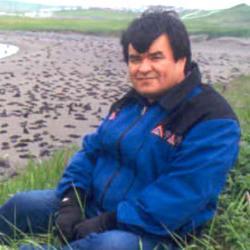 Larry Merculieff is an Aleut (pronounced like “Al’-yoot”) who, for more than three decades, held a number of cultural, economic, and political positions where he sought to preserve and communicate the need for environmental and cultural integrity from the Native Alaskan perspective. In recent years, he has advocated that the knowledge and wisdom of indigenous peoples be incorporated into discussions of the challenges facing society.
Larry Merculieff is an Aleut (pronounced like “Al’-yoot”) who, for more than three decades, held a number of cultural, economic, and political positions where he sought to preserve and communicate the need for environmental and cultural integrity from the Native Alaskan perspective. In recent years, he has advocated that the knowledge and wisdom of indigenous peoples be incorporated into discussions of the challenges facing society.
Larry’s early education was very traditional and typical for Aleut children at that time. He grew up on St. Paul’s Island, one of the Pribilof Islands in Alaska’s Bering Sea. When he was four years old, Larry was sent to live with his grandfather so that he could watch, listen, and learn from him. His traditional education was also enhanced when he was mentored by an “aachaa” (pronounced like “ot’-chaa”) from age 5 to 13. As is the custom, little verbal instruction was given. Instead, Larry was given a rich opportunity to experience and observe the ways of being a man in his culture.
He was entrusted with his first rifle at age 7, acknowledgment that the men in his community believed he understood enough about fundamental values, the hunting protocols, and the care of and respect for the animals they hunt to be a responsible hunter. At age 11, he first skippered a skiff out into the Bering Sea (up to 10 miles away) to fish for halibut. Again, this was recognition of his knowledge and skills. There was no competency test, no license to obtain; rather he had demonstrated his understanding and sense of responsibility to his community.
According to Larry, Aleut children are treated as intelligent human beings who are offered opportunities to observe and to demonstrate their understanding of the world through experiential learning.
COMMUNICATION DIFFICULTIES
Communication problems often arise from the differences between the methods of Western science and the ways in which Native people, like Larry, learn about their environment. Because of the holistic way in which Native Americans have traditionally investigated their environment, everything is contextual. As a result, it is difficult for Native Elders to answer questions asked by Western scientists without putting the answer in context.
Larry offered an example of an inquiry made by a scientist, representing the State of Alaska, who wanted information from Native Elders about how many moose would likely be available in a particular area in the next year. Moose are a staple in the diets of many Alaska Native groups, and information about the moose population would be used to help set the limits for hunting.
The scientists planned to conduct an aerial transect (a line for ecological measurement) across the region and compare the number of bulls and cows to assess the reproductive capacity of the moose population. After listening intently to the presentation, the Elders asked if the scientist had noticed more beaver dams in the area. The puzzled scientist’s response was that he didn’t study beavers. The Elders asked if lower water levels had been reported. Again the scientist responded that he didn’t do that kind of work, but suggested that maybe the state hydrologist could investigate further. The Elders pointed out that the foraging area of the moose had been shrinking because of beaver dams.
In each stage of this interchange, the emphasis was different. The scientist wanted an answer to a specific question about the reproductive capacity of the moose population, while the Elders took a broader, more holistic view of the situation.
EXPLAINING AND PREDICTING A CHANGING ENVIRONMENT
Western science depends upon a peer-review process in which scientists conduct research by gathering data, analyzing data, and publishing their findings in journals that are read by other scientists in the field of study. However, scientific data from the Arctic have often been limited to intermittent periods of collection over relatively short periods of time, usually in the milder months. In addition, limitations of funding and other resources often restrict a study to a few data sets. Until the advent of remote sensing by satellites, even data sets representing a “time series” (repeated data gathering sessions over a defined period of time) were seldom available for as much as a decade. As a result, scientific models built on limited amounts of data may not represent the environmental conditions very well. Yet they represent the “best available science that exists,” which is often given as a legal mandate for setting policy.
Contrast this with Native Ways of Knowing, which includes observations over many years, on a daily basis, usually for decades. This knowledge is shared informally through conversations and community interactions, and is related through intergenerational stories and the values, traditions, and ethics that are unique to that culture. The Native Elders are personally connected to their environment, their communities, and each other. Within the culture of the community, aberrations, changes, and anomalies are readily apparent; although not necessarily documented. Furthermore, linkages between multiple variables in an environmental setting are often inferred and explored, but may not be quantified or recorded.
Larry described an example from 1977 when the Aleuts expressed concern over changes they had observed in the Bering Sea. They saw “trouble coming.” Many observations had led them to conclude that something was very different. Sea bird chicks were unable to maintain a hold on the cliffs. The breastbones of birds were sticking out. Sea lions were eating their pups more frequently than had been observed before. The fat on the fur seals was so thin that the women processing the meat could see through the fat. Both surface-feeding birds and those that fed by diving into the water column were emaciated, and their behavior patterns were changing. These observations were considered to be anecdotal evidence, even though they reflected widespread disruption on an ecosystem level. Some Native Alaskans testified before Congress and helped to complete environmental impact statements, but it wasn’t until 1990 that scientists concluded changes were occurring in the region.
In a related story, Larry explained that the women of his community noticed that the meat of the sea lions was more orange than it had been before, and smelled “fishy.” As the community members discussed this observation, they inferred that instead of feeding on a range of fish, the sea lions had begun to feed more heavily on salmon. The Elders believe the salmon may disappear in 10 to 15 years. The response of the scientists to this observation and inference was to request that the community gather more data. A recent paper described the relatively low numbers of red salmon, but no direct connection has yet been shown.
WESTERN SCIENCE TAPS INTO NATIVE WAYS OF KNOWING
Recently, researchers have been encouraged to seek out the knowledge and wisdom of the Native peoples. How can these two different ways of understanding the natural world be combined? Scientists Philip Loring, David Atkinson, Craig Gerlach, and Terry Chapin are among those who conduct formal scientific investigations in the Arctic region and have already included, to some degree, the experience and understanding of Native Alaskans. Each offered examples from his experiences.
THE CHANGING ROLE OF NATIVE PEOPLE IN WESTERN SCIENCE
Many times when Native peoples are included in a study, they are asked to help by increasing the number and types of observations of change. In doing so, they contribute to the “groundtruthing” aspect of the research – having a person on the ground who can verify that readings from instruments are reasonable and correct. However, Philip Loring and his colleagues advocate a new position on Native peoples’ involvement in scientific research; that is, local people should be engaged throughout the process. Instead of merely observing the changes, they can help everyone understand and respond to them.
This new position takes scientists outside the usual mode of asking research questions and posing hypotheses. Instead, this model suggests that establishing a relationship and openly discussing concerns builds the trust needed to allow scientists and Native people to address shared concerns. Furthermore, engaging the community in this way can shape the research questions and foster environmentally-responsible behaviors.
Terry Chapin gave the example of people living in Wainwright, Alaska, who are hunters of ice-dependent marine mammals – walruses and seals. As sea ice is diminished, the local population has less access to these mammals. When asked, the people said they would like to know more about what is likely to happen to fish and caribou, both of which may become more important if they lose access to the marine mammals on which they have depended for generations. That knowledge will enable them to be better prepared for change, offering them the flexibility to make their best possible decisions in an uncertain future.
INCLUSIVE KNOWLEDGE
Clearly, there are cultural differences between Western science and Native Ways of Knowing. Those differences offer opportunities for each to gain from the other. In order for research scientists and Native peoples to truly collaborate in both generating the questions and shaping potential answers, it is necessary for both groups to adopt different communication strategies and processes by which they develop and organize their efforts.
Perhaps, as trust is established and both groups learn to value the other’s way of knowing, a more robust understanding will emerge. Alaska is rich with many traditions and a long history of resilient and resourceful people who lived more sustainably with nature than modern Alaskans do. Modern science can contribute information and knowledge that is difficult for Native people to assess without detailed measurements and designs. Native people can provide the context and help to assess the significance of the observations. Triangulation and sharing may offer a framework that sets up true synergy between these paradigms, while at the same time providing the “best available science” to inform and guide policy decisions as the Arctic responds to changes in climate.
This article was written by Carol Landis and Jessica Fries-Gaither. For more information, see the Contributors page. Email Kimberly Lightle, Principal Investigator, with any questions about the content of this site.
Copyright October 2009 – The Ohio State University. This material is based upon work supported by the National Science Foundation under Grant No. 0733024. Any opinions, findings, and conclusions or recommendations expressed in this material are those of the author(s) and do not necessarily reflect the views of the National Science Foundation. This work is licensed under an Attribution-ShareAlike 3.0 Unported Creative Commons license.

